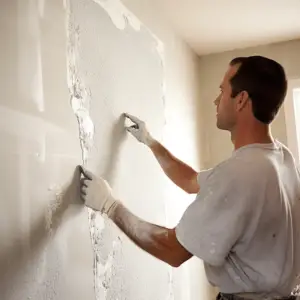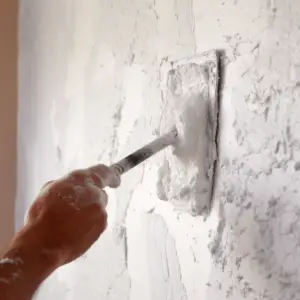Are you a drywall installer or DIY enthusiast with some drywall imperfections? Joint compound and spackle are restorative materials used when working with drywall for repair, construction, and fixing defects.
Because both look alike (are white, thick, with a paste-like consistency), do similar work, and are often used on drywall projects, most people presume they’re the same. But is there a difference between these two materials?
Drywall compound and spackle are designed for different specific purposes. However, your decision heavily depends on the project. We have this article for you to learn more about these fantastic products.
Table of Contents
What Is The Contrast Between Joint Compound And Spackle?

Before we venture into more details on the subject, here is a side-to-side snippet of both materials:
| Drywall Compound | Spackle |
|
|
Drywall Compound vs. Spackle In Details
Functionality
Drywall compound is best when it comes to taping and finishing drywall seams. On the other hand, spackle is a perfect choice for filling or repairing small to large-sized holes in your walls.
Please note that it doesn’t mean you can fill holes using a drywall compound. The only difference is that, unlike spackle. The mud will dry slower. Nevertheless, you can use the joint compound as spackle’s alternative but not vice versa (you cannot use spackle in place of the joint compound)
Drying Time
Drywall compound dries gradually than spackle. For instance, a surface filled with spackle can take an hour to cover a hole, sand, and paint, whereas applying drywall mud will take longer to dry.
Cost/Price
On Average, spackle is more costly than joint compound. However, since the latter is used to cover larger surface areas, more is required resulting in an overall higher cost. Spackle is needed in small quantities to fix a few minor damages like holes in the wall. It ends up being affordable.
Application
Spackle is much easier to use than drywall compound because it has a thinner spread, while joint compound consumes time due to the number of layers required to give a polished finish. Although it is easier to sand down, it is more dense and durable.
Shrinkage Properties
Spackle doesn’t shrink once it dries completely, unlike drywall compound, which tends to shrink, thus requiring multiple layers to get the surface a perfect finish.
What Is Drywall Compound?
A white powder comprising gypsum dust and limestone as the primary materials, including others like clay, mica, perlite, and starch, refers to as “drywall compound,” also known as (joint compound, drywall mud, or mastic)
It comes in a premixed (1 quart to 5-gallon sizes) container for your suitability or in a powdered form to mix yourself with water to form a cake frosting-like consistency. However, the joint compound’s spreadable consistency depends on the particular type of joint compound.
The mud also takes time to dry, for instance, up to 24 hours before you sand or paint it.
Drywall Mud Uses
- The primary function of the joint compound is to seam and smooth new drywall installations.
- It is best for heavy/large wall repairing projects
- Drywall mud can also seal small holes or smoothen out wall divots.
4 Types of Joint Compound
All-purpose- is suitable for all phases of the patching process
Topping- is used for the final coat, designed to spread on a wall with two dried coats of taping compound.
Quick-setting- is ideal for patching wide holes and deep cracks. It is faster to dry than the other compounds.
Taping- It sets the seam between dry walls spreading over drywall tape.
The drywall compound is relatively affordable, but it doesn’t mean you buy a large compound container for a minor repair project. Because of its consistency, some homeowners find it challenging to achieve a smooth finish when using drywall mud.
Though with some practice and patience, you will get a seamless finish
What is Spackle?
It is a product from Muralo Company that comprises gypsum powder and binding agents. Spackle has a thicker consistency compared to drywall mud. It is available in a premixed tub container and multiple grades structured for special applications.
Spackle dries faster than joint compound- roughly within half an hour, making it preferable.
Due to the binding agent blended in with gypsum powder, spackle is more elastic with non-shrinkable properties when dried.
This product is a bit pricier than drywall compound, although technically, it may not be the case. A joint compound is meant for the larger surface area, leading to more project expenditure.
Spackle Ues

It covers nail holes, dings, dents, or minor wall damage. It is designed for minor repair works on drywall.
Types of Spackle
Spackle comes in various categories, and it is crucial to note that not all its types are made for drywall use. Check below for more details:
- Lightweight Spackling Compound
Its consists of fine aggregate with sodium silicate and an adhesive. It is ideal for covering small holes, dings, and cracks. It is used for quick, minor fixes.
- All-Purpose/ Standard Spackling Compound
Like mud, the all-purpose spackle is gypsum-based and used for larger holes, gouges, and cracks in drywall.
- Vinyl Spackling Compound
It fills in holes and cracks up to ¾-inch deep by applying in multiple layers. Each layer should be allowed to dry in between applications. Due to vinyl, this type of spackle doesn’t dry out or crumble and also and well.
- Epoxy Spackling Compound
It is an oil-based filler that repairs holes, cracks, gouges, or any imperfections in the wood.
- Acrylic Spackling Compound
It is flexible and applies to drywall, brick, stone, wood, or plaster.
Spackle comes in a small container. However, you use more ounces at a time. A tub can last you for months or even years.
Drywall Compound vs. Spackle: Which One Should You Choose?
Both products are similar, although each has a distinct purpose. Drywall mud is ideal for fixing large holes and cracks to cover seams between two drywall pieces.
Conversely, spackle is more convenient for small work like filling in nail holes and other minor damages on your walls.
Now that you have been informed of these two unique products for your drywall, making a decision will be easier but remember, it all trickles down to the job you want to get done.
